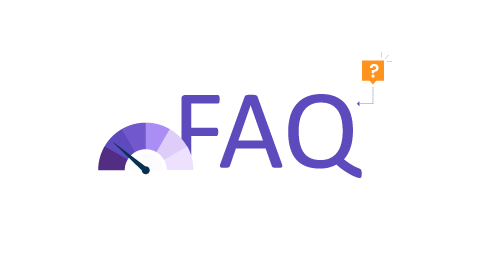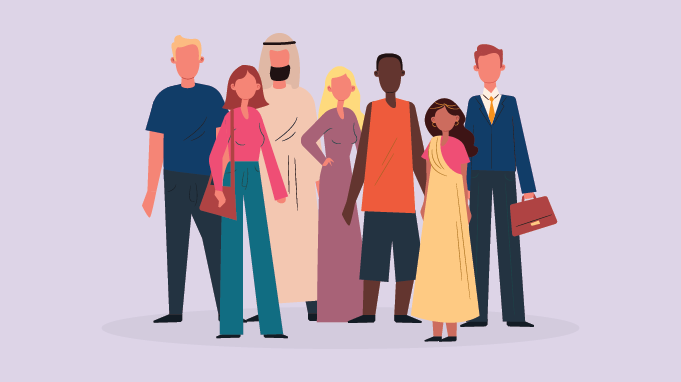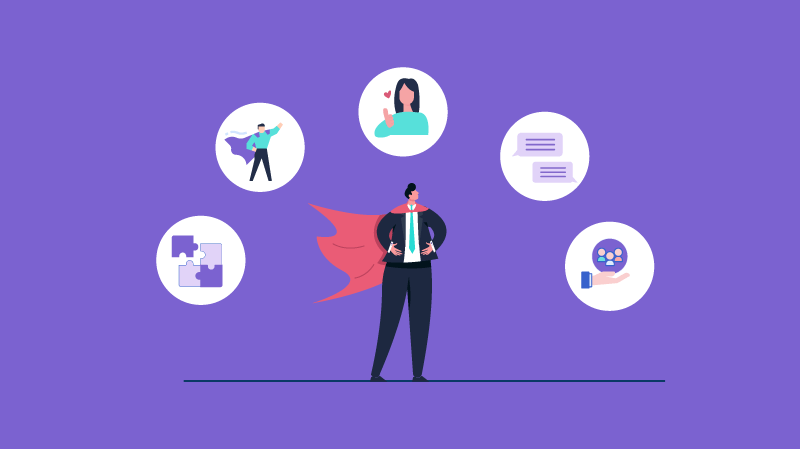10 Best Diversity and Inclusion Trends in 2024
In recent years, employers and business leaders around the world have been trying to predict the diversity and inclusion trends that will impact their work cultures the most.
The first wave of the COVID-19 pandemic, a global lockdown, major events, protests, and conversations surrounding racism, systemic inequalities, and injustices, a new normal of remote working, an economic recession: there was a lot that the world had to grapple with.
All of these changes are significant factors in determining the upcoming and ongoing D&I trends for 2024. Companies have had to rethink, update, and revamp their diversity and inclusion strategies and initiatives. Doing so will lead to the creation of an equal and inclusive workspace, where employees feel appreciated and valued, regardless of their diversities. This will push company growth and help them be on the right side of history as well.
Diversity and Inclusion Trends in 2024
What are the diversity and inclusion trends for 2024? Let’s have a look:
- An evolving remote workforce
- Enabling diverse gender identity and gender expression
- Multigenerational workforce
- Eliminating unconscious bias in the workplace
- Gearing up for systemic change
- Diversity, equity, and inclusion
- Hiring diversity professionals
- Increased transparency in goals
- Supporting employees' mental health
- Looking beyond tokenism
Let us discuss these in some detail, shall we?
1. An Evolving Remote Workforce
With the COVID-19 outbreak last year, companies had no option but to adopt a work-from-home model. Although people are slowly going back to their workplaces, the remote work model is here to stay.
According to Global Workforce Analytics, 56% of the U.S. workforce can feasibly work from home. Moreover, 25-30% of the workforce will work from home by the end of 2023.
When working remotely, different employees have different living conditions. For instance, working women are expected to balance home and work-life, access to health facilities vary depending on internet facilities and geographical locations, there might be lack of a dedicated and quiet space for employees to focus on their work, and so on.
Thus, people in leadership positions need to figure out ways to bridge these gaps, and minimize such a distributed model’s challenges.
Related Article: Diversity and Inclusion in the Remote Workplace
2. Enabling Diverse Gender Identity and Gender Expression
In recent times, there has been increasing awareness about diverse gender identities and gender expressions.
Globally, organizations have been trying to grapple best with these dynamics by adopting inclusive practices such as giving people access to gender-neutral restrooms, including employee health benefits for transitioning individuals, creating awareness around using inclusive language for gender non-binary and transgender employees, etc.
Related Article: 7 Benefits of Promoting Gender Diversity in the Workplace
3. Multigenerational Workforce
The working population has never been as diverse as present times. The generational makeup of the current workforce includes up to five different generations. This includes:
- The Silent Generation (born between 1928-45)
- The Baby Boomers (born between 1946-64)
- The generation X (born between 1965-1980)
- Millennials or Generation Y (born between 1981-96)
- The newest generation, Generation Z (born since 1997)
Each of these generations has unique expectations from their professional lives. They bring in different life experiences, voices and skill sets to a company.
It is important for employers, HR managers, and people in leadership positions to be aware of the attributes and abilities of each generation. Leaders should use different strategies that cater to, and celebrate employees of every generation.
4. Eliminating Unconscious Bias in the Workplace
Unconscious bias refers to the tendencies to process information and make decisions based on unconscious or inherent biases and prejudices toward an individual or group.
Unconscious bias impacts the kind of relationships we have with people and directs how we make decisions in the workplace.
To build a truly inclusive workforce with people from different backgrounds and experiences, business leaders must ensure that these biases are checked and minimized consistently.
5. Gearing up for Systemic Change
2020 witnessed some significant events that highlighted systemic injustices and flaws across institutions. The murders of George Floyd, Breonna Taylor, and so many innocent people of color exposed the grim realities of a racist and unjust society.
Organizations should gear up for some radical and much-needed systemic changes that will impact the functioning of societies and workplaces alike. Leaders should do their best to combat any discrimination against underreprented groups in their company. Policies should be put in place to ensure that the workplace is a safe hub for every employee.
Related Article: Confronting Discrimination in the Workplace (For Leaders)
6. Diversity, Equity, and Inclusion
Many workplaces today focus on DEI instead of D&I. DEI stands for Diversity, equity, and inclusion.
Equity has become just as crucial as D&I in several global companies.
Equity in the workplace refers to fair and impartial processes and outcomes for each individual in the company.
To ensure fair and impartial processes and outcomes, leaders and employers need to be mindful of the challenges, barriers, and advantages at play for everyone at any given point in time.
Equity is the reminder that not everyone starts at the same level playing field, and so swift and vigilant action is paramount to building a fair workplace.
Related Article: How to Promote Workplace Equity? Here are 7 Effective Ways!
7. Hiring Diversity Professionals
Yup, you read that right. It is interesting how ‘Diversity Professionals’ is a relevant job role at workplaces.
Companies are now hiring diversity professionals who are committed to the vision and mission of creating a diverse and inclusive workplace. These job roles are a mix of HR, recruitment, and leadership roles and responsibilities.
Diversity professionals carry on a number of tasks such as holding and organizing educative sessions on diversity and inclusion, creating an inclusive culture in the workplace, introducing new ideas to improve D&I in the workplace, rooting and pushing for the use of an inclusive language, managing complaints on harassment and workplace discrimination, etc.
As the role of diversity professionals have become increasingly popular, the trend of hiring them is only predicted to grow this year.
Related Article: How to Improve Your Diversity Recruitment Strategy
8. Increased Transparency in Goals
We know that more diversity in a company does not necessarily equal more equity and inclusion. While efforts at diversity may increase, the same is not always the case for efforts at inclusivity.
A growing diversity and inclusion trend in 2024 will be for companies to set transparent targets, goals, and D&I initiatives. Doing so will increase accountability of people in leadership positions, encourage honest conversations between employees and their bosses, and inspire them to share ideas and solutions.
Related Article: 8 Tips on How to Have Difficult Conversations With Employees
9. Supporting Employees’ Mental Health
The unprecedented arrival of a global pandemic and its aftermath was a blow to the mental health of employees and professionals across the globe.
Even though the conversation around the mental health and wellbeing of employees was already gaining traction in the past couple of years, 2020 witnessed it take a whole new turn.
With businesses shutting down, people losing jobs, adjusting to the new normal of working from home, and the constant health scare of getting coronavirus, there was a lot that hampered the peace and sanity of employees.
Consequently, a relevant diversity and inclusion trend in 2024 will be for organizations to take intentional steps at supporting the mental health of its diverse pool of talent. This does not only include putting effective policies in place. The simple things like how supervisors, managers, and coworkers talk, behave, and empathize with each other matter as well.
Related Article: How Can Managers Support Mental Health in the Workplace
10. Looking Beyond Tokenism
Diversity and inclusion is much more than hiring that one POC, or including one woman in a panel full of men.
In 2024, it is time for organizations to do something solid and not just the bare minimum when it comes to incorporating D&I initiatives in place.
Diversity just for the sake of diversity, or political correctness, will not make the cut anymore.
Diversity and inclusion have to be done more dynamically. For instance, merely greeting employees during a festival like Ramadan will not work.
Employers and HR professionals must empathize with them while observing fast. Moreover, employers must take proactive steps to assist and support Ramadan observing employees. They have to show respect for their culture and tradition.

It is now time for organizations to be more mindful, and intentional, about their diversity and inclusion goals and strategies.
Diversity and Inclusion Trends- FAQs

1. What are Diversity and Inclusion Trends?
D&I trends are nothing but how a workplace can become more inclusive, diverse, and equal. It promotes diversity and equity using the right methods without offending anyone.
2. What is the difference between Diversity and Inclusion?
Diversity refers to welcoming, hiring, and giving opportunities to people from all sorts of backgrounds, races, cultures, gender, sexuality, age, ethnicity, etc. It is about making your workplace diverse by hiring the right talent for all sorts of minorities and differences.
On the other hand, inclusion is about how your workplace accepts, respects, and gives equal and fair treatment to all employees, irrespective of their diverse identities, gender, and sexualities.
3. What are the types of Diversity?
- Age
- Disability
- Gender reassignment
- Race
- Religion or belief
- Sex
- Sexual orientation
4. How to promote Diversity and Inclusion at work?
There are multiple ways to promote D&I at work, and to begin with; you can start making a framework and organize sensitization programs for awareness. Hire more people from diverse backgrounds. Promote gender equality.
Celebrate diversity in the workplace on special events like Juneteenth, Black history month, pride month, and others. And you can take reference from the diversity and inclusion trends mentioned in this blog to promote D&I at work.
Final Words
Diversity and inclusion is now much more than a ‘progressive idea’ or concept. It has now become the need of the hour for organizations worldwide.
The above-mentioned diversity and inclusion trends only point to the fact that the world is hungry for radical change. It is time that organizations realize this and mold their company culture in all the right ways.
How many of these D&I trends do you notice in your company? How do you pursue them? Did we miss something worth mentioning?


















